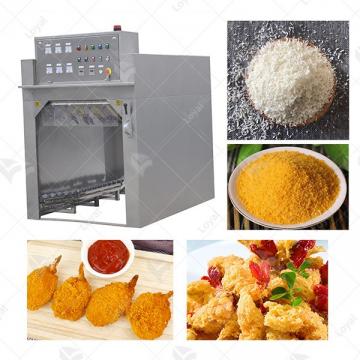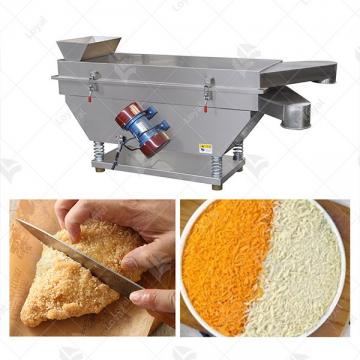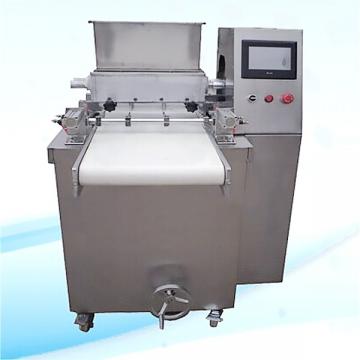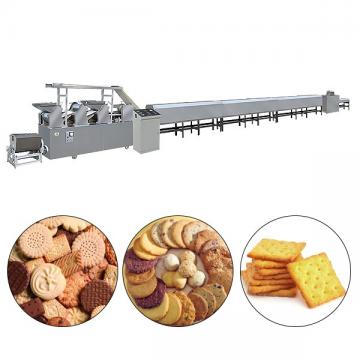
- Shandong Loyal Industrial Co.,Ltd.
- Macaroni Production Machine Instant Noodle Machine Biscuit Making Machine
Home> Processing> The ultimate transformation of flour: The possibilities of instant noodle production machines

The ultimate transformation of flour: The possibilities of instant noodle production machines
2025-05-06 10:38:09The global instant noodle industry is experiencing an unprecedented wave of growth. According to the latest data from the World Instant Noodles Association (WINA), global consumption of instant noodles exceeded 60 billion in 2024, with Africa's market growing by a staggering 37%, and Southeast Asia maintaining stable growth of 8-10%. This phenomenon is driven by multiple factors.

'The explosive growth in the instant noodle market is primarily due to three key factors,' said Robert Chen, President of the International Food Machinery Association. 'Firstly, the widespread adoption of fast-paced lifestyles globally, secondly, the expansion of the middle class in emerging markets, and most importantly, the continuation of home economy consumption habits formed during the pandemic.'
However, this prosperous scene conceals serious challenges. Traditional instant noodle production lines generally have high energy consumption, with a single line consuming up to 1.5 million kilowatt-hours annually. As global carbon neutrality policies advance, environmental regulations such as the EU Carbon Border Adjustment Mechanism (CBAM) are pushing the industry towards technological innovation.
In this context, a new generation of fully automatic instant noodle production machines has emerged. This equipment uses groundbreaking energy-saving technology, reducing energy consumption by 50% compared to traditional devices while maintaining or even improving production efficiency. Test reports from Japan's Food Machinery Research Institute show that production lines using the new microwave drying technology have reduced unit product energy consumption from 1.2 kWh/kg to 0.6 kWh/kg.
'Energy saving is not only an environmental requirement but also a key factor for companies to reduce costs,' emphasized Zhang Mingyuan, Deputy Secretary-General of the China Food Industry Association. 'In the current situation where the cost of instant noodle raw materials is rising, reducing production energy consumption directly affects the profit margins of companies.'
This innovative solution has been introduced at a critical time for industry transformation and upgrading, providing instant noodle manufacturers with a powerful tool to respond to market changes. In the following sections, we will delve into the technical principles and market advantages of this revolutionary equipment.

An overview of the instant noodle production line
The core objective of modern instant noodle production lines is to achieve efficiency, stability, and automation to meet the continuously growing global market demand. A complete instant noodle production line typically includes the following key stages: dough mixing, where high-quality wheat flour is combined with water and other essential ingredients to create a smooth, elastic dough; sheeting, where the dough is rolled out into thin sheets using precision rollers; cutting, where the sheets are sliced into precise noodle shapes by sharp blades; drying, where the cut noodles are carefully dried to remove moisture while maintaining their texture and flavor; seasoning and packaging, where the dried noodles are paired with savory seasonings and vacuum-sealed in convenient, resealable packets; quality control, where each batch undergoes rigorous testing to ensure consistency and safety; and finally, storage and distribution, where the finished products are stored under optimal conditions before being shipped to retailers worldwide.
Flour mixing - compounding - boiling - cutting and bending - frying - cooling - packaging
- Mixing
Mixing dough is the first crucial step in instant noodle production, directly affecting the final taste and quality of the noodles. Traditionally, flour and water are mixed in a specific ratio (usually 100:28-35) and supplemented with salt and alkali to enhance the dough's elasticity. Modern fully automatic production lines use vacuum mixing technology, stirring the dough in a sealed environment to prevent air from mixing in, making the dough tighter and more elastic.
Compared to regular mixers, vacuum mixing reduces dough bubbles, making subsequent rolling processes smoother and resulting in more uniform sheets. Additionally, a dual-axis mixing design ensures thorough mixing of materials, avoiding clumping or uneven moisture distribution. Some high-end equipment also features an automatic feeding system for precise control of ingredient ratios, reducing manual intervention and improving batch consistency.
Optimizing this stage not only enhances the noodle texture but also lowers defect rates in subsequent production steps, laying the foundation for efficient and continuous industrial production.
- Rolling and shaping
Rolling and shaping is a crucial step in processing dough into uniform sheets, directly determining the chewiness and final texture of the noodles. Modern production lines use continuous compound calendering processes, where the dough passes through multiple precision rollers for repeated rolling, gradually forming sheets with consistent thickness and tight structure.
Compared to traditional single-machine calendering, compound calendering offers significant advantages: through progressive rolling by 5-7 rollers, the gluten network is fully extended, making the final product more elastic and resilient. The gap between each roller is precisely calculated, starting from 10-15mm and gradually reducing to 1.0-1.2mm, ensuring sheet uniformity with an error margin of ±0.05mm.
Advanced calendering equipment is equipped with automatic thickness adjustment systems, which monitor sheet quality in real-time using laser thickness gauges and automatically adjust roller pressure. Additionally, food-grade stainless steel rollers have specially treated surfaces to ensure hygiene standards and prevent sheet adhesion.
Some high-end models also feature temperature control systems to maintain optimal working temperatures for the rollers, ensuring stable calendering quality. This innovative process not only enhances noodle quality but also significantly increases production efficiency. Modern compound calendering machines operate at speeds of 30-50 meters per minute, two to three times faster than traditional equipment, providing high-quality raw materials for subsequent steaming processes.
- Steaming
Steaming is a crucial stage in the production of instant noodles, where precise temperature and humidity control ensure that the starch in the noodles fully gelatinizes and the proteins undergo moderate denaturation, giving the final product its unique texture and flavor. Modern steaming systems use a tunnel-style continuous steamer design, allowing the noodles to receive uniform heat treatment while being conveyed at a constant speed.

Advanced steaming equipment features the following key characteristics:
- Three-stage temperature zone control: a preheating zone (60-70℃), a main cooking zone (95-100℃), and an insulation zone (85-90℃), designed in a gradient to ensure starch gelatinization exceeds 85%
- Steam circulation system: Achieves uniform distribution of steam through porous jet devices, with temperature difference controlled within ±1℃.
- Smart humidity control: Maintains relative humidity between 90-95% to prevent the surface of the noodles from drying out and cracking.
Precise control of steaming time is particularly crucial, typically set between 2 to 4 minutes. If the time is too short, the starch won't gelatinize properly, making the noodles sticky; if too long, the noodles become too soft, affecting their subsequent shaping. Modern equipment is equipped with variable frequency speed control devices, allowing flexible adjustment of the conveyor belt speed based on different product requirements, achieving stepless regulation from 30 seconds to 5 minutes.
In terms of energy-saving technology, the new steamer uses:
- Heat recovery system: Utilizing the thermal energy from discharged steam to preheat incoming water
- Double-layer insulation structure: reduces heat loss
- Automatic water replenishment system: maintains optimal water levels, prevents energy waste
The stability of the steaming process directly affects the uniformity of product quality, noted a renowned food machinery engineer. By using a PLC automatic control system, we have achieved precise coordination of steam pressure, temperature, and time parameters, ensuring that the degree of gelatinization variation between batches is within 2%.
This optimization not only improves product quality but also reduces unit energy consumption by 15-20%, bringing significant economic benefits to production enterprises. The steamed dough sheet then proceeds to the shaping process, preparing for subsequent frying or hot air drying.
- Fried/non-fried drying process
The drying process is the core step that determines the final quality and characteristics of instant noodles. Modern instant noodles making machines mainly use two techniques: frying and non-frying, each with its own features and suited to different market demands.

The frying and drying system:
Using high-temperature rapid dehydration to give instant noodles their distinctive crispy texture and rich flavor. Modern frying equipment features the following technical characteristics:
- Segmented temperature-controlled frying tanks: Utilizing 3-5 independent temperature zones (with a gradient change from 140-160°C) to ensure even frying.
- Automatic oil circulation filtration system: Capable of processing 5-8 tons of oil per hour, extending the lifespan of edible oil.
- Microwave-assisted frying technology: Combining microwave preheating to reduce frying time by 30% and lower oil absorption rates.
Frying time is typically controlled between 60-90 seconds, with precise conveyor belt speed adjustments to reduce moisture content in the dough sheets to 3-5%. Advanced frying systems are equipped with:
• Automatic oil level compensation device
• Exhaust gas recovery and treatment system
• Online acid value monitor
Non-fried drying systems:
Using hot air or microwave drying to meet health-conscious dietary needs:
- Multi-layer mesh belt hot air drying: temperature of 80-100°C, duration of 30-40 minutes;
- Microwave-hot air combined drying: leveraging the rapid heating of microwaves and the uniform drying of hot air;
- Far-infrared assisted drying: enhancing thermal energy efficiency and reducing drying time by 20%
5.Cooling and packaging
The cooling and packaging stages of the automatic fried instant noodle making production line are crucial for ensuring product quality and extending shelf life. During the cooling process, the production line employs a sophisticated progressive three-stage cooling system. Initially, powerful convective air cooling rapidly reduces the temperature of freshly dried noodles from a scorching 60°C down to a more manageable 40°C. The intense airflow whisks away heat with precision, ensuring the noodles retain their texture and elasticity. The noodles then transition into a balancing zone where they cool gradually to a comfortable 25°C, allowing the moisture within to stabilize without compromising the integrity of the product. Finally, the noodles reach ambient room temperature in the stabilization zone, where they rest quietly, their aroma subtly mingling with the surrounding air. This meticulously segmented cooling method effectively prevents the noodles from cracking due to abrupt temperature fluctuations, while a specially designed mesh belt ensures uniform cooling, allowing each strand to achieve optimal consistency and freshness. The entire process is a harmonious blend of technology and culinary science, culminating in a product that promises both quality and longevity.

Parameter
|
Item |
Output |
|
LYN-ll 3Y |
30,000pieces/8h |
|
LYN-ll 6Y |
60,000pieces/8h |
|
LYN-ll 8Y |
80,000pieces/8h |
|
LYN-ll 10Y |
100,000pieces/8h |
|
LYN-ll 12Y |
120,000pieces/8h |
|
LYN-ll 16Y |
160,000pieces/8h |
|
LYN-ll 18Y |
180,000pieces/8h |
|
LYN-ll 20Y |
200,000pieces/8h |
|
LYN-ll 30Y |
300,000pieces/8h |

FAQ:
①What does after-sales service include?
A: • Basic services:
◦ Free installation and commissioning + operation training
◦ 1-year full machine warranty
• Value-added services (optional):
◦ Remote monitoring system (real-time fault diagnosis)
◦ Annual maintenance plan
②Does the equipment meet food safety certification requirements?
A: Certifications: CE, , ISO 22000 certifications.
Material Safety: All parts that come into contact with food are made of 304 stainless steel, eliminating any risk of contamination.
③How automated is the production line? Is it necessary to have a technician operate it?
A: • Automation level:
◦ The entire process from raw material input to packaging is fully automated, requiring only manual input of raw materials and random inspections.
◦ Touchscreen control allows for one-button start-up after parameter settings.
• Operational difficulty:
◦ Ordinary workers can be trained to operate within 1 to 3 days.
◦ We provide operation manuals in both Chinese and English along with a fault code guide.
As one professional small instant noodles making machines manufacturer, our instant noodle making machine is designed to optimize the instant noodles manufacturing process. The instant noodle machine utilizes high-quality ingredients such as wheat flour, water, salt, grain flour, and vegetable juice to produce a variety of instant noodles. These include fired instant noodles, unfried instant noodles, and Indomie-style instant noodles, all of which are ready for sales. The machine ensures a consistent texture and flavor, making each batch of noodles a delightful culinary experience.
If you want to know more story about LOYAL brand, here can help you - https://www.facebook.com/foodmachineloyal
 Commercial Japanese Panko Bread Crumb Grinder Machine
Commercial Japanese Panko Bread Crumb Grinder Machine Japanese Bread Crumbs Processing Line
Japanese Bread Crumbs Processing Line Automatic Cookies Making Machines
Automatic Cookies Making Machines Fully Automatic Biscuit Making Machines
Fully Automatic Biscuit Making Machines